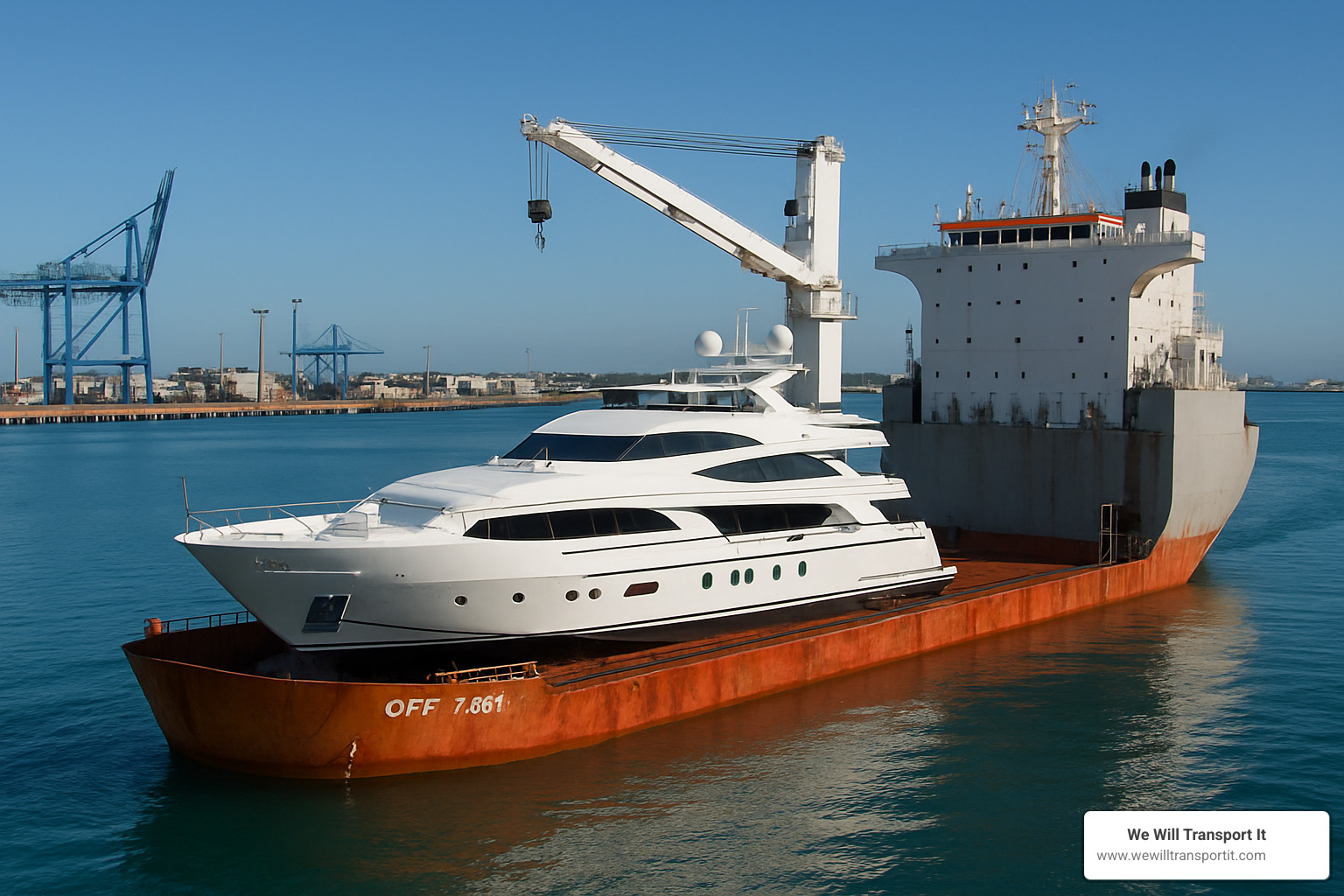Why Professional Boat Transport by Sea Is Essential for Today’s Yacht Owners
Boat transport by sea offers yacht owners a safe, efficient way to move their vessels across oceans without the wear, crew costs, and weather risks of self-delivery. Here’s what you need to know:
Top Sea Transport Methods:
- Float-on/Float-off – Semi-submersible ships for yachts 35-150 feet
- Roll-on/Roll-off – Drive-on service for trailerable boats
- Container/Flat Rack – Secure options for smaller vessels
- Lift-on/Lift-off – Crane loading for custom requirements
Key Benefits:
- No engine hours or wear on your boat
- Professional handling by trained loadmasters
- Fixed sailing schedules you can plan around
- Comprehensive marine insurance coverage
The global yacht transport industry has grown tremendously as more owners find seasonal cruising between destinations like the Mediterranean and Caribbean. Professional carriers now operate extensive fleets with regular sailing schedules between major cruising destinations.
But choosing the wrong transport partner can lead to delays, hidden fees, and even damage to your prized vessel. The key is understanding your options and working with experienced professionals who handle every detail.
I’m William Meyer, and I’ve coordinated over 15,000 vehicle and equipment transports in my decade-plus career, including numerous boat transport by sea projects for clients moving everything from fishing vessels to luxury yachts. In this guide, I’ll walk you through everything you need to make an informed decision about shipping your boat safely across the world’s oceans.
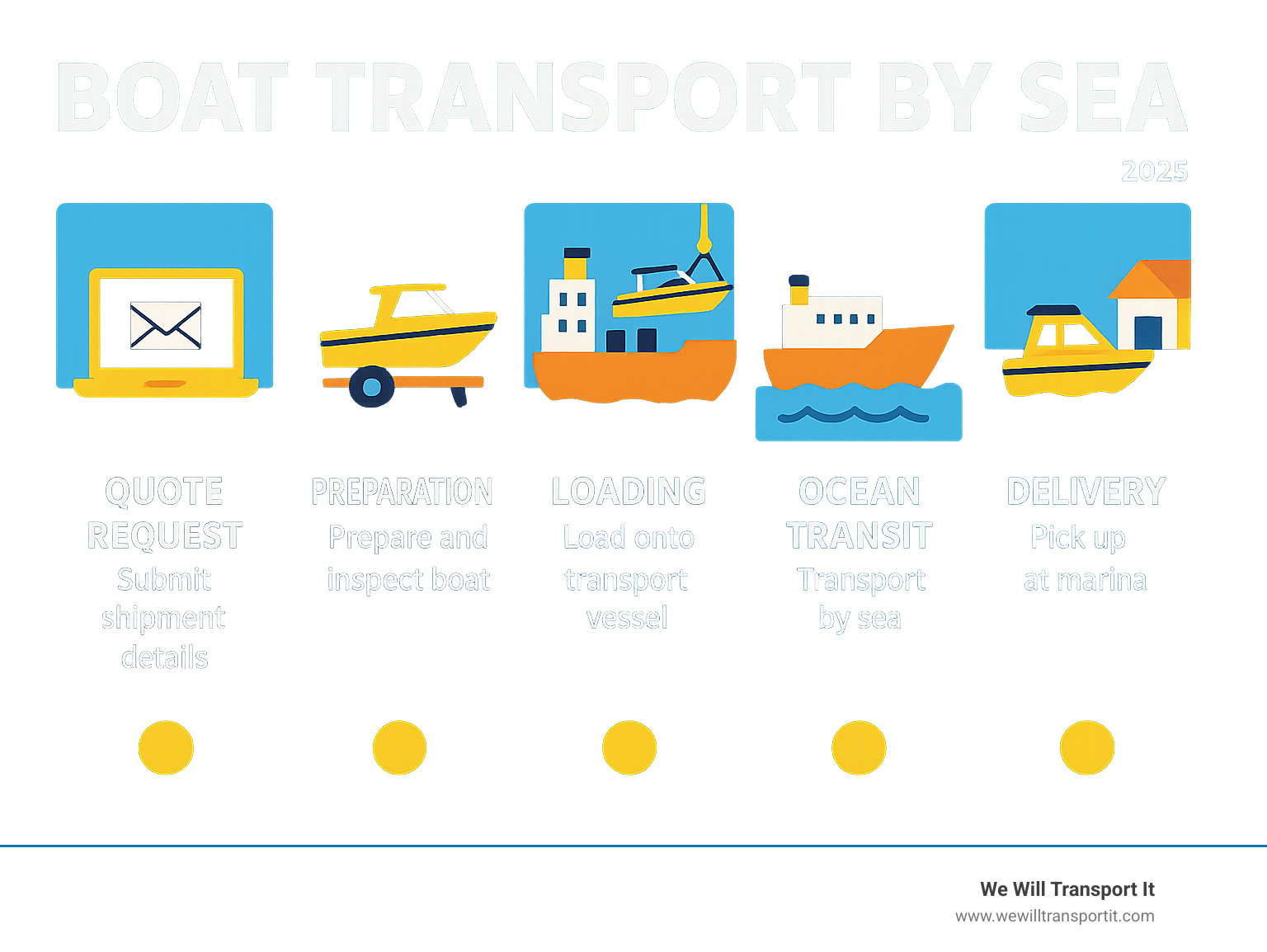
Why This Guide Matters
When you’ve invested hundreds of thousands—or even millions—in your dream yacht, peace of mind isn’t negotiable. The global shipping industry has grown tremendously, with specialized yacht carriers now offering weekly sailings between major cruising destinations. This growth means more options for owners, but also more complexity in choosing the right service.
We’ve seen too many horror stories: boats damaged by inexperienced handlers, owners stuck with unexpected port fees, or vessels delayed for weeks due to poor planning. That’s why we created this comprehensive guide—to help you steer the process with confidence and avoid costly mistakes.
What Is Boat Transport by Sea?
Boat transport by sea is essentially having your yacht hitchhike a ride on a much bigger ship. Instead of sailing your vessel across oceans yourself—dealing with weather, crew costs, and putting engine hours on your boat—you let the professionals handle the heavy lifting while you fly to your destination.
Think of it like this: your boat becomes cargo on a specialized carrier designed specifically for transporting yachts. These aren’t your typical freight ships hauling containers of sneakers. We’re talking about sophisticated vessels engineered to carry million-dollar yachts safely across thousands of miles of open ocean.
The industry has developed several types of ocean carriers to handle different boats and situations. Semi-submersible ships are the workhorses of yacht transport—they literally sink their decks underwater so your boat can float right on. Cargo liners use massive cranes and custom cradles to lift vessels into position. Container vessels can carry smaller boats tucked safely inside standard shipping containers, while roll-on/roll-off ferries let you drive trailerable boats right up adjustable ramps.
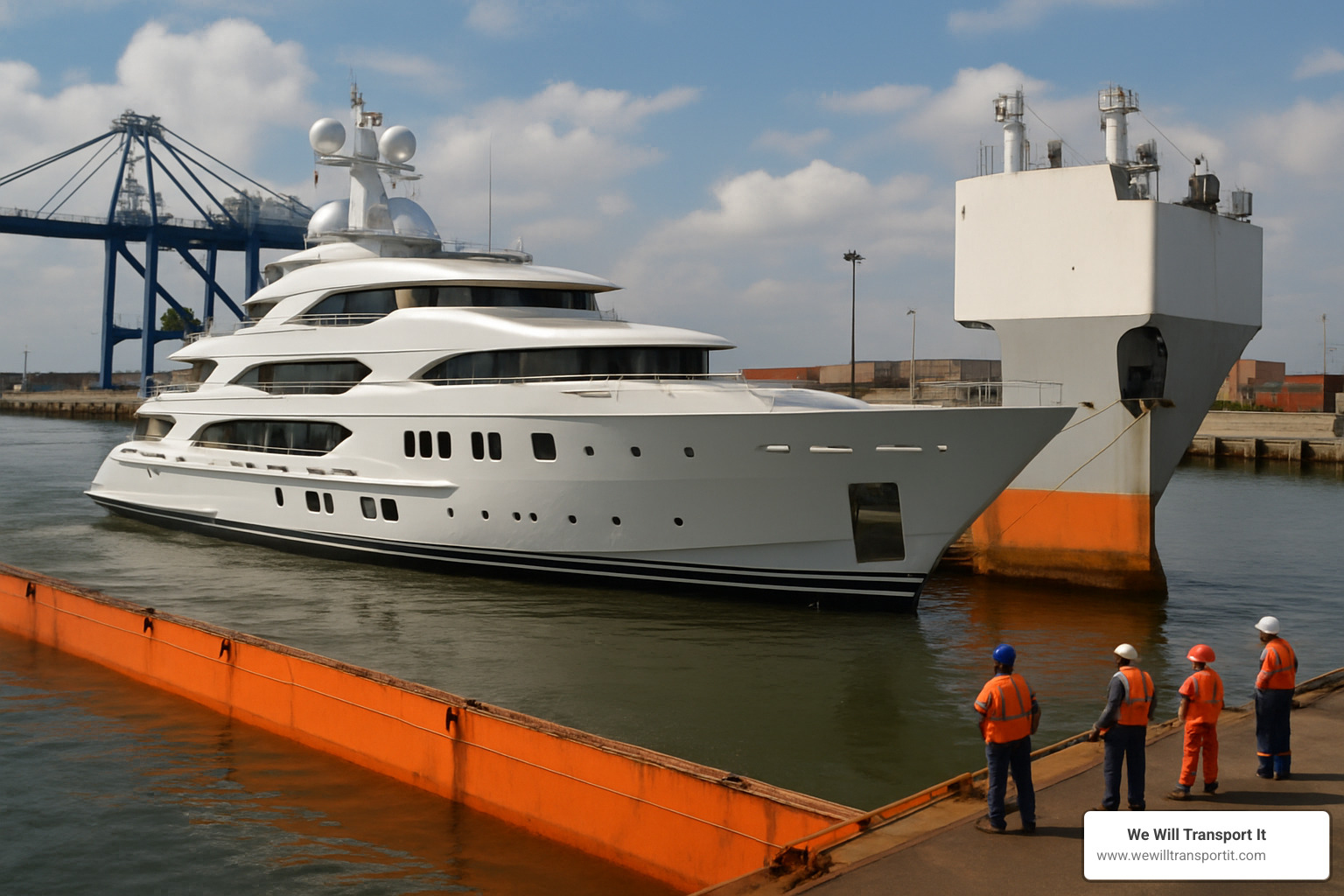
How Boat Transport by Sea Works
The magic starts with careful route planning. These carriers operate on fixed schedules between major ports. Popular routes like the Mediterranean to Caribbean run have weekly departures, while more exotic destinations might only see monthly sailings.
For float-on/float-off operations—the most common method for larger yachts—the process is genuinely fascinating. The carrier floods its ballast tanks with seawater, causing the deck to sink below the surface. Your yacht literally floats onto this submerged platform, where skilled loadmasters guide it into position using custom cradles and securing systems.
Once everything’s perfectly positioned, the ship pumps out the ballast water. As the deck rises, your boat emerges from the ocean, now safely cradled aboard the carrier for its journey.
Here’s how the three main transport options stack up:
| Method | Best For | Typical Cost | Transit Time | Wear on Vessel |
|---|---|---|---|---|
| Sea Transport | 35-150 ft yachts | $15,000-$75,000+ | 2-6 weeks | None |
| Road Transport | Under 12 ft beam | $2,000-$15,000 | 3-10 days | Minimal |
| Self-Delivery | Seaworthy vessels | $5,000-$25,000 | 1-4 weeks | High |
The beauty of boat transport by sea is that your vessel arrives exactly as it left—no additional engine hours, no storm damage, no crew drama.
Main Methods & Suitable Vessel Types
When it comes to boat transport by sea, there’s no one-size-fits-all solution. The industry has developed several specialized methods that can handle everything from your weekend fishing boat to that gleaming 150-foot yacht you’ve been dreaming about.
Float-on/float-off carriers work beautifully for larger yachts between 35 and 150 feet, especially motor yachts and substantial sailing vessels. The process is incredibly gentle on your hull since there’s minimal lifting involved.
For smaller boats that already live on trailers, roll-on/roll-off service makes perfect sense. Your boat simply drives aboard via ramps, just like loading onto a car ferry.
Container shipping offers excellent protection for boats up to 40 feet long that fit within standard dimensions. Flat rack shipping uses open platforms with custom cradles for boats that are too big for containers but don’t quite need the full float-on treatment.
Lift-on/lift-off using shore cranes works perfectly for unique situations where your boat or the port facilities require a more customized approach.
Float-On Float-Off Explained
Semi-submersible carriers flood their cargo decks several feet below the ocean surface using sophisticated ballast systems. Your yacht approaches this submerged deck under its own power or with a helpful tug.
There’s virtually no lifting stress on your hull. The loadmasters guide your boat into position using predetermined cradle locations engineered specifically for your hull shape. Once everything’s perfectly positioned, the ship’s pumps remove the ballast water and gradually lift your boat clear of the sea.
The whole process feels remarkably similar to normal docking procedures, which is why yachts over 45 feet do so well with this method.
Container & Flat Rack Options
Standard 40-foot containers provide excellent security and weather protection for smaller vessels. The dimensions work perfectly for many cruisers, fishing boats, and smaller sailboats—you get 7 feet 10 inches of height and 7 feet 8 inches of width to work with.
Flat racks come into play for boats that exceed container dimensions but don’t justify float-on service. These open platforms use custom-built cradles designed for your specific hull shape.
Roll-On/Roll-Off for Trailerable Craft
If your boat already lives on a trailer, this method couldn’t be more straightforward. The port ramps are designed to accommodate various trailer configurations, and your boat drives aboard just like loading onto a car ferry.
You’ll need oversize permits if your boat exceeds 8 feet 6 inches wide or 13 feet 6 inches high, and sometimes escort vehicles are required for the largest loads.
Budget & Timeline Considerations for Boat Transport by Sea
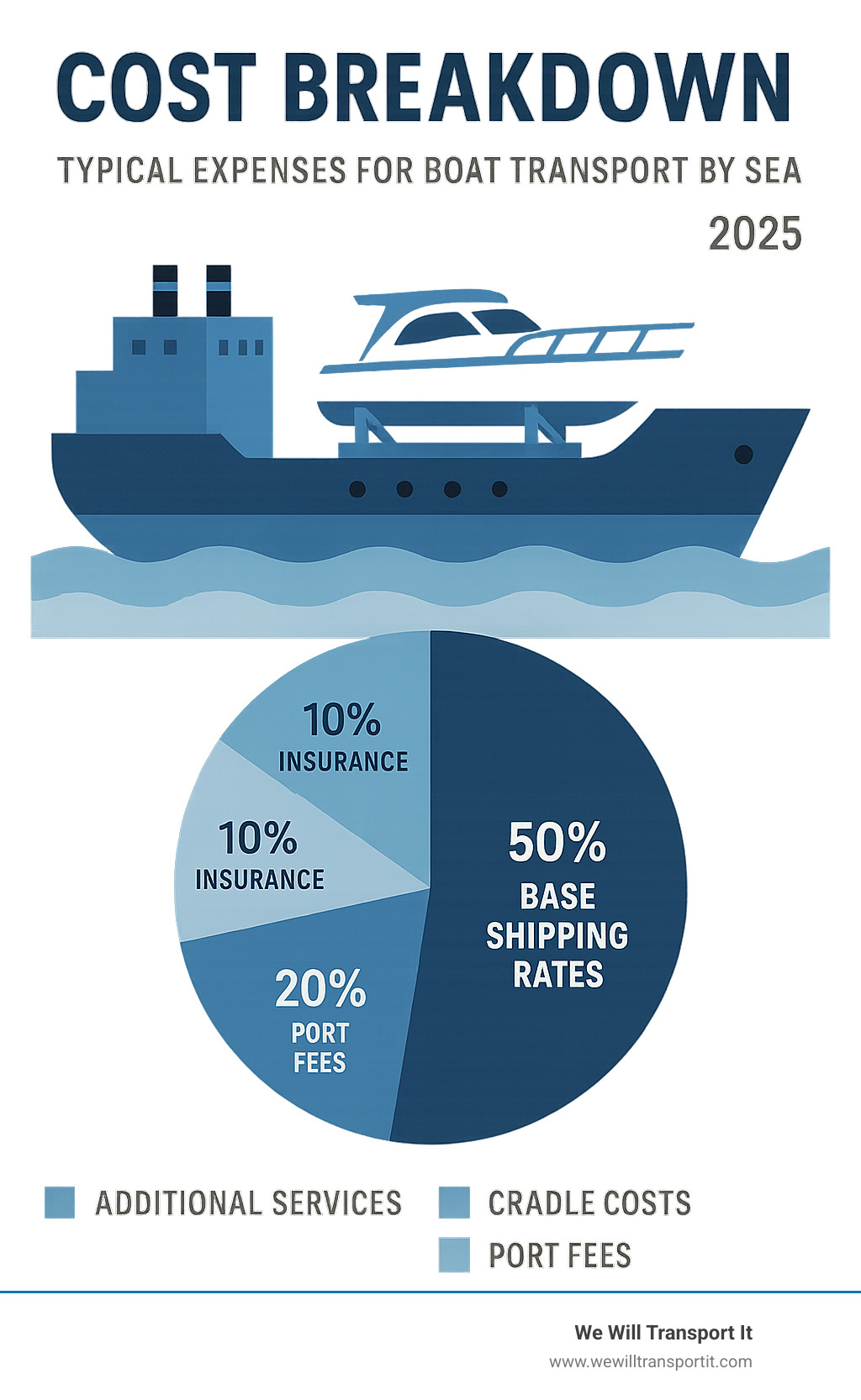
When planning your boat transport by sea budget, think beyond the base shipping quote. The real cost includes several moving parts that can catch owners off guard if they’re not prepared.
Distance forms the foundation of your transport cost. A transatlantic crossing for a 50-foot yacht typically runs $15,000 to $40,000, while shorter hops like Florida to the Bahamas might cost $8,000 to $15,000. Your boat’s size makes an even bigger difference—that same Mediterranean to Caribbean route could cost $12,000 for a 35-foot sailboat but jump to $60,000 for a 100-foot motor yacht.
Seasonality hits both your wallet and your schedule. Peak season from September through November sees rates climb 20-30% as everyone rushes to move boats before winter.
The hidden costs add up fast. Port fees vary wildly between locations, cradle hire depends on your boat’s specific needs, and insurance premiums reflect your vessel’s value. Don’t forget fuel surcharges that fluctuate with oil prices.
Transit times typically span 2 to 6 weeks depending on your route and carrier. Fixed sailing schedules help with planning, but weather delays and port congestion can stretch your timeline.
Understanding pricing formats helps you compare quotes fairly and avoid surprises.
Cost Drivers Owners Overlook
Cradle fabrication represents the biggest surprise for many owners. If your boat needs custom cradles—and most unique hull shapes do—expect $3,000 to $8,000 in additional charges.
Stevedore charges for loading and unloading operations often appear as separate line items. These port labor costs can add $2,000 to $5,000 per operation.
Import duties catch many owners completely off guard. While temporary import permits often waive duties for visiting yachts, permanent imports can trigger substantial fees.
Lay-days accumulate when delays happen beyond the carrier’s control. Weather preventing loading or port strikes delaying departure can cost $500 to $1,500 per day.
How Long Will It Take to Reach Port?
Sailing frequency varies dramatically by route. Popular corridors like Mediterranean-Caribbean might offer weekly departures during peak season, while less common routes could sail monthly or even quarterly.
Weather buffers built into schedules help carriers maintain reliability, but severe conditions still cause delays. Hurricane season in the Atlantic and typhoon season in the Pacific create particular challenges.
Canal transits through Panama or Suez add complexity and potential delays. These critical chokepoints operate on strict schedules, and missing a transit slot can delay your shipment by days or weeks.
Step-by-Step Process & Preparation
Getting your yacht ready for boat transport by sea doesn’t have to feel overwhelming. Think of it as a well-choreographed dance that unfolds over 8-12 weeks, with each step building naturally toward your boat’s safe ocean crossing.
The journey begins when you request a quote during weeks 1-2. Provide your boat’s exact length overall (LOA), beam, air draft, displacement, and clear photos. Wrong measurements can derail your entire timeline and cost you thousands in additional charges.
During weeks 3-4, many carriers require a professional survey and measurements for valuable yachts. The surveyor documents your boat’s condition and verifies every dimension for cradle design and loading plans.
Booking confirmation happens around weeks 5-6 once you accept the quote. The carrier reserves your deck space and their engineers start designing your specific loading plan.
The documentation preparation phase during weeks 7-8 often catches owners off guard. International shipments require extensive paperwork including customs forms, insurance certificates, and sometimes export licenses.
Loading day arrives around week 9, typically taking 4-8 hours depending on your boat size and loading method.
During the ocean transit phase lasting 2-6 weeks, your boat travels secured in its cradle while you travel separately. Modern carriers provide GPS tracking and regular updates.
Finally, unloading and delivery reverses the loading process at the destination port.
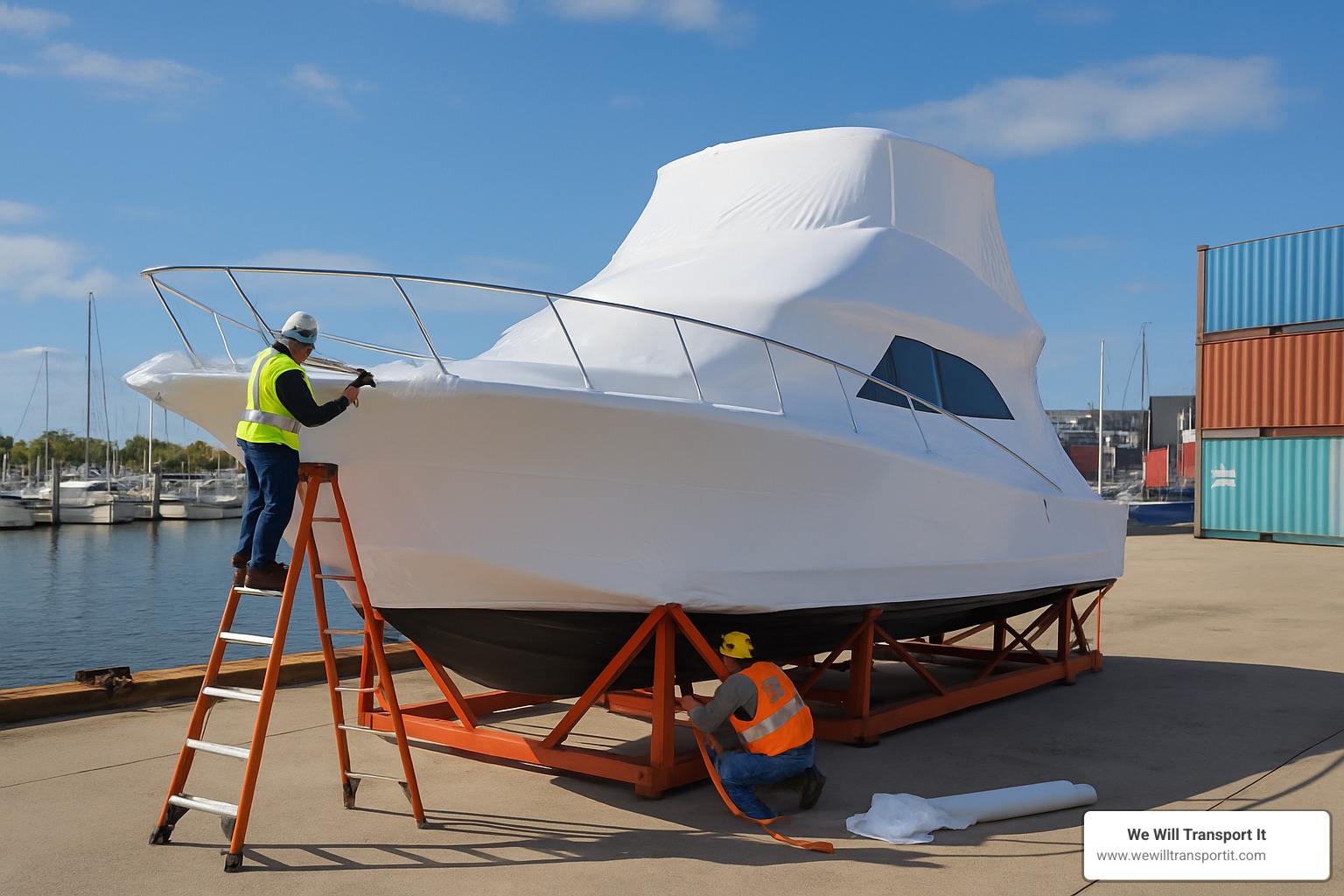
Pre-Shipment Checklist
Proper preparation prevents problems and ensures smooth loading operations. Start this process at least 4 weeks before your scheduled loading date.
Verify your measurements with all equipment in transport position. Lower radar arches, fold antennas, and remove any items that increase height or width.
Drain your systems to reduce weight and eliminate spill risks. Empty fuel tanks to 1/4 capacity or less, drain fresh water systems, and pump out holding tanks.
Disconnect your batteries to prevent drainage and potential fire hazards. Remove or secure any loose electronics that could shift during transport.
Winterize your engines and systems to protect them from salt air exposure during the ocean crossing.
Professional shrink-wrapping protects your boat’s interior from salt spray and weather. It also deters theft and keeps your vessel clean during port handling.
Remove all personal items before loading. Carriers typically prohibit personal belongings aboard transported boats.
For more detailed guidance on international preparations, check out these International Boat Transportation Tips.
Regulatory & Environmental Compliance
Environmental regulations have become increasingly strict for vessel transport. Invasive species prevention requires thorough hull cleaning and sometimes official washdown certificates before loading.
Ballast water rules apply to the transport vessel itself, but some jurisdictions extend requirements to transported boats.
The EPA’s Vessel General Permit program establishes specific requirements for commercial vessels, including yacht carriers. You can learn more about these specific shipping regulations on the EPA’s website.
Customs documentation varies by destination but typically includes vessel registration, insurance certificates, and owner identification.
Export licenses may be required for high-value yachts or those containing restricted technology.
Safety & Insurance Basics
Marine all-risk policies provide the most comprehensive coverage for transported yachts. These policies cover physical damage, theft, and general average contributions during the ocean crossing.
Declared value determines your coverage limits and premium costs. Accurate valuations prevent disputes if claims arise.
Deductible amounts typically range from $2,500 to $25,000 depending on your boat’s value.
Professional survey reports document your boat’s pre-transport condition and help establish values for insurance purposes.
The uShip Protection Plan offers additional coverage options for some transport arrangements, though specialized marine policies usually provide better protection for valuable yachts.
Choosing a Reputable Partner for Boat Transport by Sea

Finding the right partner for boat transport by sea can make or break your entire experience. After coordinating thousands of transports, I’ve learned that the difference between a smooth journey and a costly nightmare often comes down to choosing the right company from the start.
The best carriers treat your boat like the valuable asset it is, not just another piece of cargo. They understand that whether you’re moving a cherished family cruiser or a million-dollar yacht, you need partners who combine technical expertise with genuine care for your investment.
Credentials form the foundation of any reputable transport company. Look for Federal Maritime Commission (FMC) licensing for international routes—this isn’t optional paperwork, it’s proof they meet strict safety and financial responsibility standards. For any overland portions of your transport, FMCSA numbers show they’re legitimate operators who follow federal regulations.
Loadmaster expertise separates the professionals from the amateurs. These skilled specialists understand how different hull shapes behave during loading, which cradle configurations work for your specific boat, and how to secure everything safely for rough ocean crossings.
In-house engineering capabilities become crucial when your boat has unusual dimensions or special requirements. Companies that can design custom cradles and loading plans handle complex situations smoothly.
Modern real-time tracking systems keep you informed throughout your boat’s journey. GPS monitoring, regular photo updates, and proactive communication show you’re working with professionals.
Customer reviews and references provide the real story behind glossy marketing materials. Don’t just read online reviews—ask for direct contact information for recent customers who shipped similar boats on your intended route.
Red Flags & Must-Ask Questions
Several warning signs should send you looking elsewhere immediately. Hidden fees that suddenly appear after booking suggest either poor planning or deliberate deception. Professional carriers provide comprehensive quotes upfront that include all foreseeable costs.
Limited sailing schedules with vague departure dates often indicate brokers who charter space on various ships rather than owning their own vessels.
Outsourced crews create accountability nightmares. When something goes wrong, you want to deal directly with the company that owns the vessel and employs the crew.
Vague insurance coverage descriptions should raise immediate red flags. Reputable carriers clearly explain their coverage limits, exclusions, and claims procedures.
Before signing any contract, ask these essential questions: Do you own your transport vessels or charter space from others? What specific experience does your loadmaster have with boats like mine? Can you provide references from customers who shipped similar vessels on this route?
For complex shipments involving oversized boats or special requirements, permit issues can become complicated. Our detailed guide on Required Permits for Boat Transport Explained Clearly covers everything you need to know about navigating these regulatory requirements smoothly.
The best transport partners operate more like specialized logistics providers than simple freight movers. They assign dedicated project managers to oversee your shipment from booking through delivery.
At We Will Transport It, we’ve built our reputation on transparent pricing, real-time updates, and the expertise to handle complex international shipments. We understand that your boat represents more than just an asset—it’s your gateway to trip, family memories, and the freedom of the open water.
Frequently Asked Questions about Boat Transport by Sea
How much does boat transport by sea cost on average?
The cost of boat transport by sea depends heavily on your boat’s size, your chosen route, and when you’re shipping.
For the popular Mediterranean to Caribbean route during peak season, expect to pay $15,000 to $25,000 for a 35-45 foot sailboat. A 50-65 foot motor yacht typically runs $25,000 to $45,000, while larger superyachts between 80-100 feet can cost $50,000 to $85,000 or more.
US East Coast to Mediterranean shipments cost slightly more due to longer distances. A 40-50 foot powerboat usually runs $18,000 to $30,000, while 60-75 foot yachts range from $35,000 to $55,000.
The Pacific Coast to Hawaii route offers some savings compared to Atlantic crossings. Sailboats between 35-45 feet typically cost $12,000 to $20,000, while 50-65 foot motor yachts run $22,000 to $35,000.
But here’s what catches many owners off guard—these base rates don’t include everything. Custom cradles can add $3,000 to $8,000 if your boat has an unusual hull shape. Port handling charges typically run $2,000 to $5,000 per port, and marine insurance costs 0.5% to 1.5% of your boat’s value.
Don’t forget preparation services like shrink-wrapping and winterization, which can add another $2,000 to $6,000. Peak season pricing can increase these costs by 20-30%.
What documentation and permits are required for international routes?
International boat transport by sea involves more paperwork than most owners expect. The good news is that experienced carriers handle much of this complexity, but you’ll still need to gather several key documents.
Every international shipment requires basic documentation: your vessel registration or Coast Guard documentation, proof of ownership, and a marine insurance certificate with at least $300,000 coverage. For boats over $500,000, most carriers require a recent professional survey.
Customs documentation gets more complex depending on your destination. You’ll need a commercial invoice or purchase receipt, a detailed equipment inventory, and sometimes import/export permits for high-value vessels. Many countries offer temporary import bonds for visiting yachts.
Environmental compliance has become increasingly strict. Most destinations now require hull cleaning certificates and invasive species inspection reports.
Special situations create additional requirements. US boats over $500,000 often need export licenses from the State Department. European destinations involve VAT documentation, while places like Australia and New Zealand have strict quarantine clearances.
The key is starting this process 6-8 weeks before shipping. Our International Boat Transportation Tips guide covers these requirements in detail for specific destinations.
How is my boat’s condition documented and protected during transit?
Professional carriers understand that your boat represents a major investment—often with deep emotional value too. That’s why reputable companies use comprehensive documentation and protection systems throughout the entire transport process.
Before loading even begins, your carrier should conduct a thorough photo survey of all surfaces, noting any existing damage in a detailed condition report. They’ll inventory equipment with serial numbers and verify measurements to ensure proper cradle fit.
Physical protection involves multiple layers of safeguards. Custom-engineered cradles distribute your boat’s weight properly across the hull, while soft goods protect contact points from scratches or pressure marks. Professional shrink-wrapping shields your vessel from salt spray and weather.
During transit, quality carriers provide GPS tracking for real-time location updates and use weather routing to avoid severe conditions when possible. Longer voyages include regular inspection reports and photo updates at key milestones.
At delivery, the process reverses with a complete post-transport condition survey. Comparison photos highlight any changes, equipment gets verified against the pre-loading inventory, and you’ll receive a formal delivery receipt with detailed condition notes.
At We Will Transport It, we’ve coordinated thousands of these shipments and understand that clear documentation and communication give you the peace of mind you deserve when shipping your prized vessel across the world’s oceans.
Conclusion
Boat transport by sea opens up a world of cruising possibilities that would otherwise require long, expensive, and potentially risky delivery voyages. Whether you’re following the sun between the Mediterranean and Caribbean, exploring new cruising grounds in the Pacific, or simply need to relocate your vessel for personal reasons, professional sea transport provides a safe and efficient solution.
The key to success lies in informed planning and choosing the right transport partner. Understanding the different transport methods, preparing your vessel properly, and working with experienced professionals makes the difference between a smooth experience and a costly nightmare.
Think of it this way: you wouldn’t drive your car across the ocean to get to Europe, so why put unnecessary wear and tear on your boat? Professional boat transport by sea eliminates engine hours, reduces crew costs, and removes the stress of weather routing and ocean crossings. Your boat arrives fresh and ready for cruising while you arrive rested and ready to enjoy it.
At We Will Transport It, we’ve built our reputation on transparent pricing, real-time communication, and expertise in complex shipments. Our nationwide network includes specialized partners for boat transport by sea, ensuring your vessel receives professional handling whether you’re shipping a weekend fishing boat or a luxury superyacht.
From our locations across the United States—including Florida, New Jersey, Oklahoma, Mississippi, and Wisconsin—we coordinate seamless logistics that take the stress out of boat transport. Our real-time tracking systems keep you informed throughout the journey, while our transparent pricing means no surprise fees or hidden costs.
The global cruising freedom that sea transport provides is truly remarkable. Imagine spending winter in the warm Caribbean waters, then having your boat professionally transported to the Mediterranean for summer cruising—all without the time, expense, and risk of ocean crossings.
Ready to explore your options for professional boat transport? Our experienced team can evaluate your specific needs and connect you with the right transport solution. For yacht owners seeking comprehensive guidance on the entire transport process, our detailed guide on Transporting Your Yacht provides additional insights and best practices.
The world’s oceans await—let us help you get there safely and efficiently. Contact We Will Transport It today to discuss your boat transport by sea needs and find how our expertise can make your next maritime trip possible.
